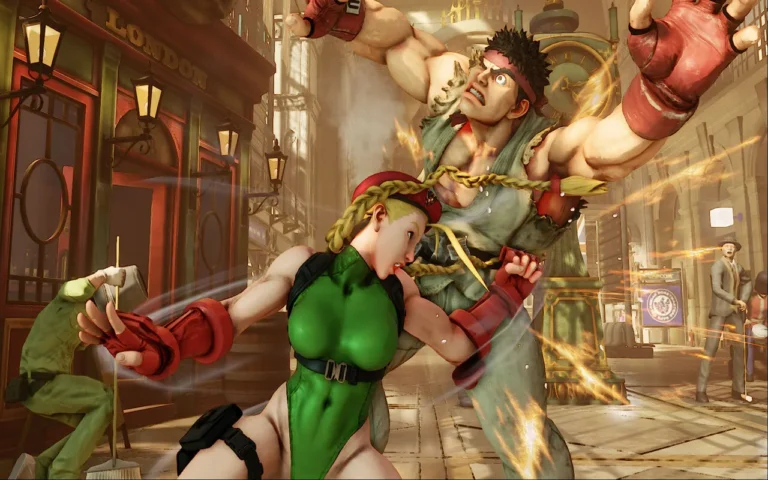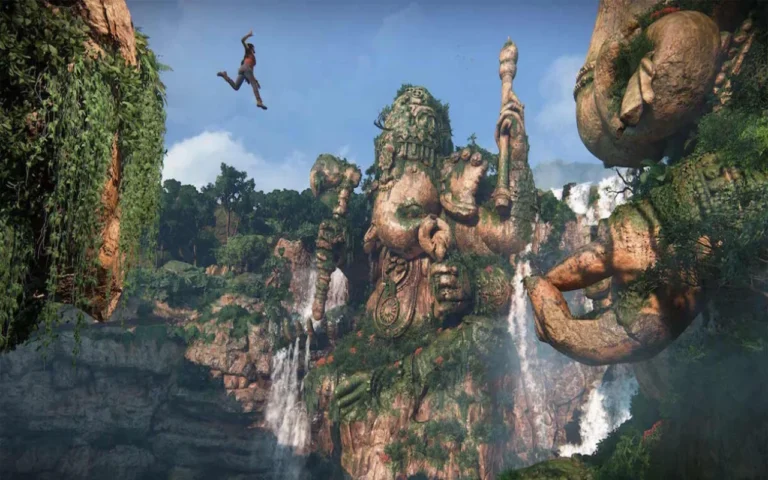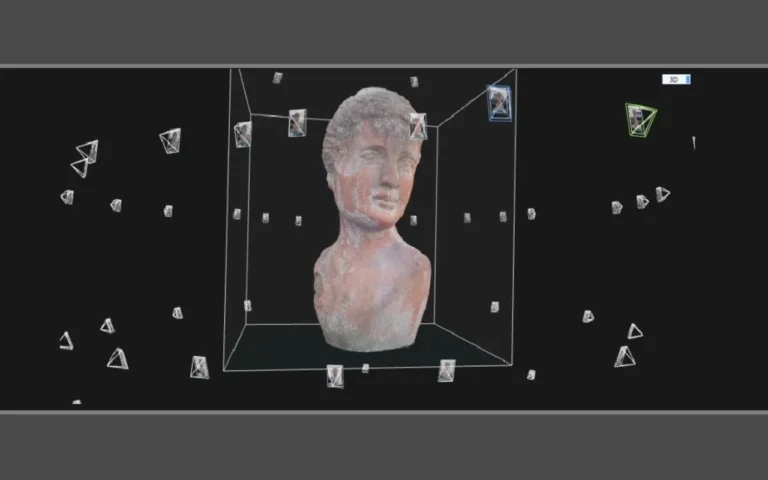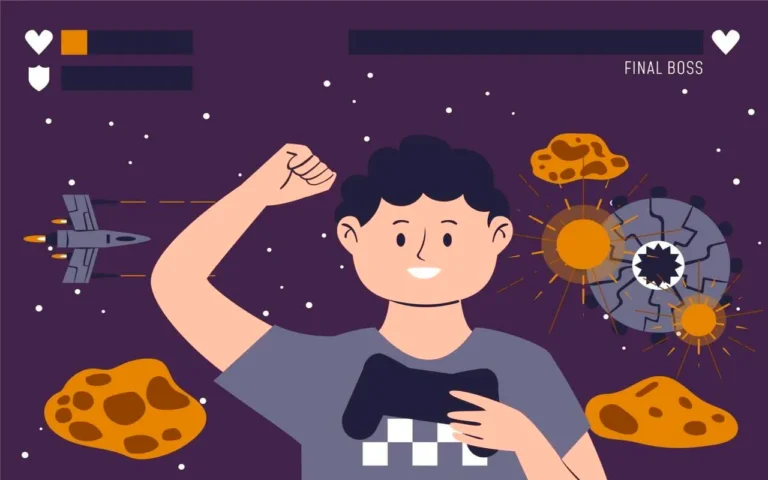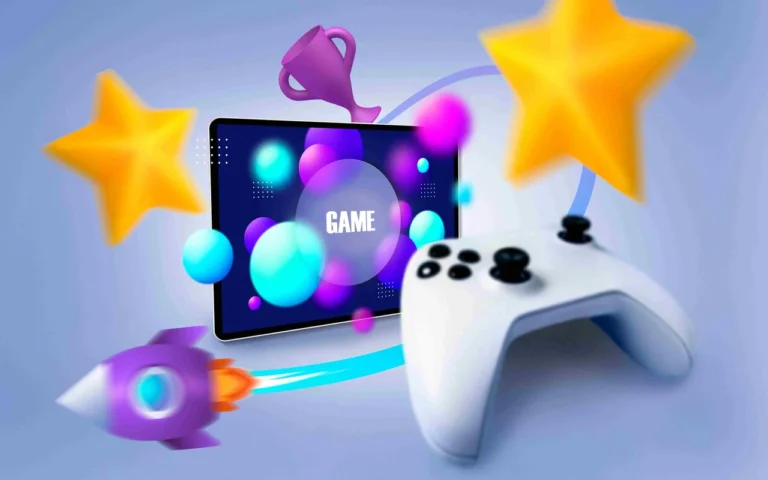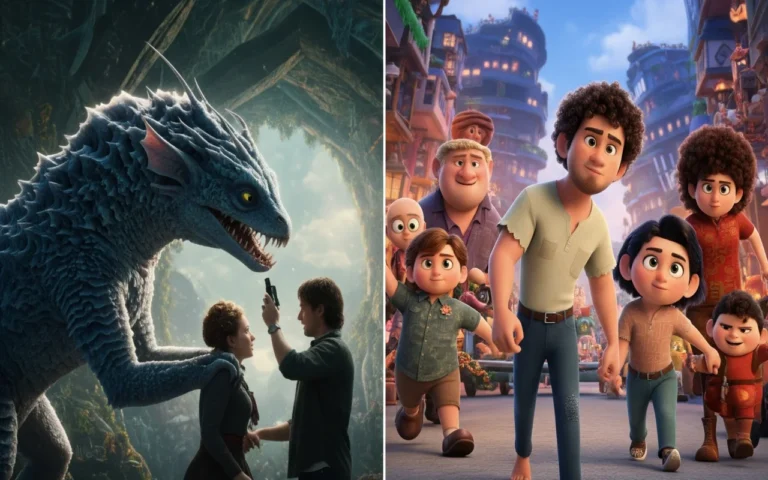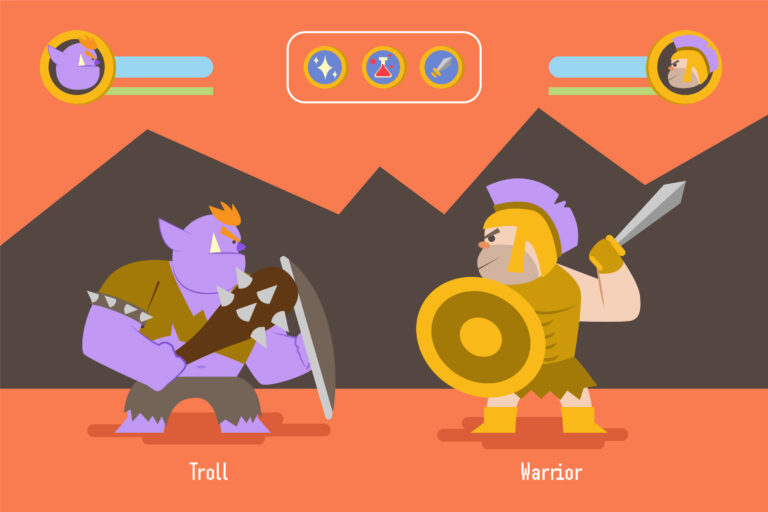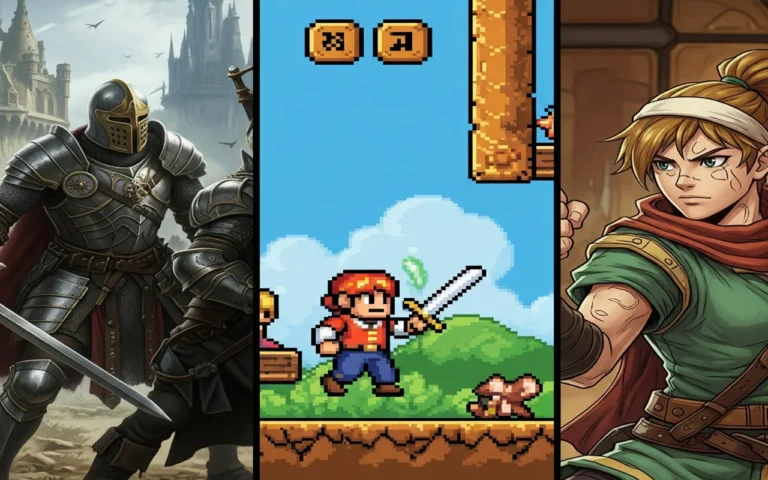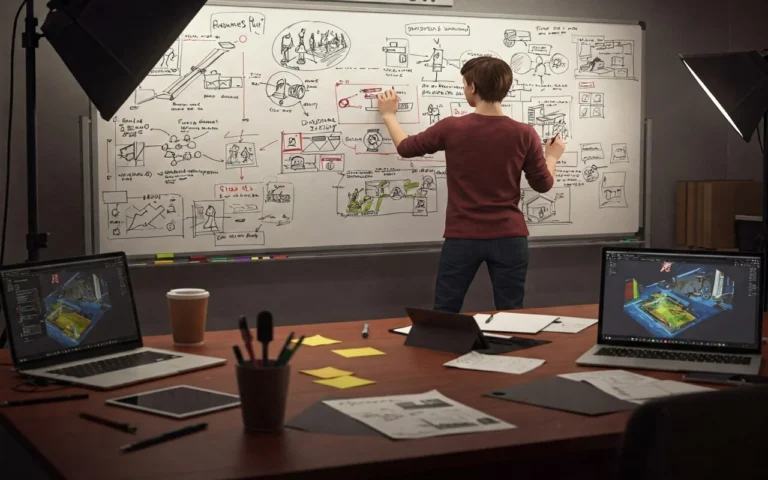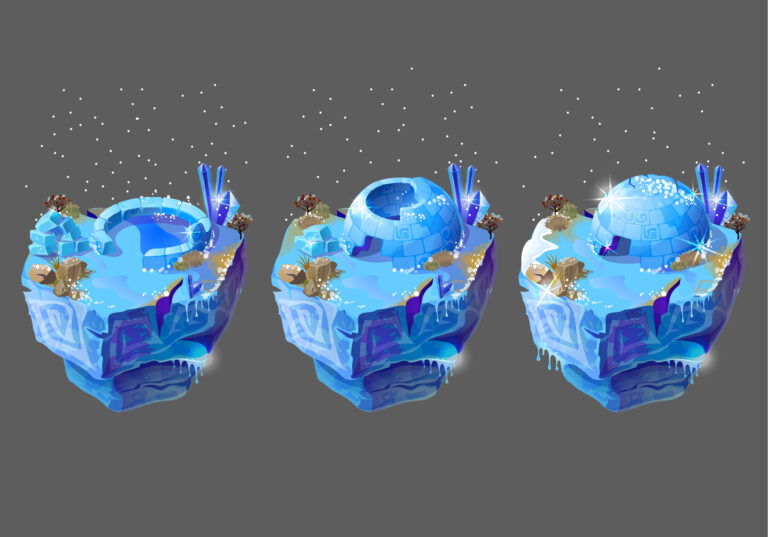The game design process provides a structured framework for turning an idea into an interactive experience. Every phase, from the initial creative game concept to ongoing post-launch support, demands creativity, collaboration, and technical expertise within the game development pipeline.
Understanding this framework is key for every game art studio, from small indie game development studios to large AAA game development teams, to minimize wasted effort and maximize player engagement.
In this article, we will explore each phase, from concept art to release, so you can successfully build games that are artistically compelling and commercially viable.


Need Game Art Services?
Visit our Game Art Service page to see how we can help bring your ideas to life!
How Do Great Game Concepts Begin?
Hit video games grip our imaginations, allowing us to traverse wondrous lands, outwit cunning foes, or construct civilizations spanning virtual ages.
Let’s explore the fundamental steps, from defining the core emotional identity to crafting a compelling “high concept” hook, that guide a creative vision from a simple thought into a viable, exciting blueprint for development.
Cultivating Core Concepts
At the heart of every game concept lies a core principle: a formalized statement of purpose that precisely defines the players’ intended feelings, actions, and memories.
Through extensive brainstorming, deep reference studies, and visual mood boards, participants in the game design process meticulously explore multiple ideas, always emphasizing emotional resonance and the core gameplay loop’s identity.
The objective is to harmonize enjoyment, challenge, and intention into a single, cohesive art direction.
Understanding Market Opportunities and Player Needs
Irrespective of how innovative an idea is, it must successfully address a genuine, real-world demand. Utilizing market research helps pinpoint underserved market niches, current trends in game mechanics, and the audience’s overall expectations.
Using specialized tools such as SteamDB and Sensor Tower, along with community insights from platforms like Reddit, provides vital information on what players are currently embracing and what they feel is missing.
Practical Implementation Factors That Shape Feasibility
A brilliant idea can fail if it lacks logistical stability. Before fully committing to specific features, designers must critically evaluate available time resources, the team’s specific expertise, and any applicable technology constraints (for instance, using Unreal Engine or Unity).
Conducting an early-stage feasibility analysis that covers feature scoping, budgetary constraints, and required pipeline implementation is preventive. It stops overly ambitious game concepts from collapsing midway through development.
The High Concept “Hook”: Why Players Should Care
The High Concept is the project’s elevator pitch: a brief, emotionally evocative summary that instantly piques the interest of both players and publishers. Typically, it strategically combines the core genre, the desired tone, and a unique differentiator.
For instance, a description like: “Dark Souls meets Pokémon in a decaying fantasy world” immediately communicates both the core gameplay loop and the intended mood. A powerful High Concept acts as the driving force for marketing efforts, securing funding, and maintaining design consistency throughout the entire production pipeline.
What Happens During Pre-Production?
The journey from a promising idea to a finished game requires a vital, often underestimated, intermediate phase: pre-production.
If the initial game concept is the spark, then pre-production is the process of building a concrete, stable foundation necessary to support the entire game development pipeline.
Feature Scoping and Requirements Gathering
The pre-production phase fundamentally establishes the practical boundaries of the game concept. Development teams meticulously itemize must-have and nice-to-have functionalities, prioritizing features that directly reinforce the core gameplay loop.
Feature creep is a major threat at this stage, making detailed documentation and strict approval protocols essential for managing feature scoping. Achieving clarity in this stage results in significant time savings later in the game development pipeline.
Creating the Art Bible and Style Guide
Establishing an art bible is crucial to ensuring visual consistency throughout the project. This document formally dictates the overall tone, the possible character color palette, necessary proportions, lighting guidelines, and the animation style, all of which must accurately reflect the game’s inherent identity.
This resource enables artists, animators, and UI designers to maintain coherence across all assets, even when working simultaneously or in geographically dispersed locations.
Evaluating Pipelines, Tools, and Team Capabilities
The selection of appropriate tools: For instance, using Unreal Engine or Unity for game engines, Perforce or Git for version control systems, and Blender or Maya for Digital Content Creation (DCC) software. This directly determines the overall efficiency of the production pipeline.
A thorough evaluation of pipeline implementation ensures that assets flow smoothly and efficiently between departments in the game development pipeline. This stage is also critical for identifying any specific training requirements for the team and for documenting technical limitations.
Prototyping and Validating Core Mechanics
Prototyping is the process that translates the theoretical game design process into immediately testable experiences. Rapid, iterative cycles of creation and review help to instantly reveal which game mechanics are genuinely fun, which are functionally broken, and what requires further refinement.
Employing gray-box level design or using placeholder art ensures that the primary focus remains squarely on the core gameplay loop’s feel rather than its visual fidelity. Successfully validated prototypes are the benchmark for all subsequent milestones.
How Are Levels and Environments Designed?
Level design and environment design are two distinct, yet highly collaborative, disciplines that structure the player’s experience in a game world. While level design focuses on structure and mechanics, environment design focuses on aesthetics and background design to create immersive, story-driven spaces.
What Is Level Design?
Level design fundamentally structures the player’s overall journey. It meticulously defines the spatial arrangements, primary objectives, and various challenges that, together, shape the game’s pacing and difficulty.
Highly effective levels strike a crucial balance between flow and tension, intuitively guiding players while also preserving their sense of agency. Designers rely on initial blockouts, analytical heatmaps, and extensive iterative playtesting to continually refine engagement and accessibility.
What Is Environment Design?
Environment design focuses specifically on the aesthetic quality and atmosphere of the game world. It conveys the narrative design through deliberate choices in architecture, lighting, and material textures.
Unlike level design, which primarily focuses on game mechanics, environment design emphasizes evoking emotion and fostering immersion.
When these distinct disciplines engage in close cross-departmental communication, the result is core gameplay loop spaces that feel vibrant, highly believable, and inherently story-driven.
Supporting Core Mechanics through Level Layouts
Exceptional levels are designed to enhance the fundamental system design of the game. Whether the goal is to facilitate strategic combat arenas or optimize efficient traversal routes, every decision concerning the layout must reinforce the core gameplay loop.
Designers rigorously test factors such as player readability, enemy placement, and resource distribution to ensure accurate game balancing. A robust level structure ensures the game mechanics shine rather than cause frustration.
Guiding Players Intuitively
Subtle visual cues, such as lighting variations, color contrast, recognizable landmarks, or specific NPC behavior, guide players without relying on explicit on-screen instructions.
Games like The Last of Us and Portal demonstrate mastery of this subtle directional technique. When executed proficiently, navigation seamlessly becomes an intrinsic component of the overall environmental storytelling rather than a dependency on the user interface (UI).
Environmental Storytelling and Mood Crafting
The strategic placement of objects, combined with the manipulation of weather conditions and scenery, can effectively convey narrative subtext without dialogue. A burned-out village or an alleyway with flickering neon lights can instantly reveal the world’s history and overall tone.
Environmental storytelling transforms what might otherwise be static assets into living memory. This technique adds considerable depth and rewards attentive players with a much richer world-building experience.
Pacing and Gameplay Variance for Engagement
Alternating levels of intensity is key to keeping players thoroughly invested. Designers intentionally balance high-action sequences with moments of quiet exploration or puzzle-solving breaks to prevent player fatigue.
Lighting effects, sound design, and the level design geometry are orchestrated to collaboratively establish an effective emotional rhythm. Well-paced environments sustain player engagement by strategically deploying variety and contrast.
How Does System Design Tie It All Together?
System design is the architectural discipline that ensures all deifferent components of a game work together harmoniously. It takes the overall game concept and defines the rules and structures that govern how players interact with the world and how the world responds.

Defining Core Gameplay Loops
The Core Gameplay Loop serves as the essential heartbeat of any game; it is the perpetually repeated sequence of actions that keeps players actively engaged. A typical loop, for example, includes collect → upgrade → battle → repeat.
System design participants formally define these loops to ensure they are fully aligned with the player’s underlying motivation and the intended reward pacing. A robust loop ensures the entire experience remains satisfying over hours of sustained play, thereby contributing to strong player retention.
Establishing Variable Interdependencies
Within a game, complex systems, such as the economy, artificial intelligence (AI), combat, crafting, and progression, are inherently interconnected.
System designers map these interdependencies using tools such as flowcharts or detailed spreadsheets to maintain overall game balancing. A comprehensive understanding of these complex relationships ultimately facilitates cohesive, emergent gameplay.
Balancing Mechanics and Difficulty Curves
The process of game balancing converts what might otherwise be chaos into a genuine challenge. Through data tracking and iterative adjustments, designers ensure that the game mechanics reward player skill without ruining curiosity or experimentation.
Tools such as Dynamic Difficulty Adjustment (DDA) algorithms and detailed statistical telemetry help maintain art’s impact on game mechanics with fair play conditions. This level of consistent tuning directly leads to higher player satisfaction and improved long-term player retention.
The Role of Continuous Playtesting
No static document or spreadsheet can replace playtesting. It is the primary method for exposing usability issues, identifying pacing problems, and uncovering hidden bugs at the earliest possible stage of the game development pipeline.
Utilizing methods like internal quality assurance (QA), targeted focus groups, and controlled closed betas helps gather actionable data for essential refinement and iterative improvement.
What Happens in the Production Phase?
The production phase is where the vision solidified during pre-production is finally executed at full scale. It is the longest, most resource-intensive stage of the game development pipeline, focused on creating assets, writing code, and integrating game mechanics to form the final product.
Let’s review how success in this phase hinges on creative output, disciplined organization, and effective team management.
Implementing Pipelines and Optimizing Workflows
After pre-production concludes, game assets transition into full-scale game production. Streamlined production pipelines are vital for ensuring that the concept art, animation, programming, and game design process teams all operate in perfect synchrony.
Using automated builds, specialized bug-tracking systems, and robust version control (such as Perforce or Git) significantly reduces operational friction. Efficiently implementing game art optimization techniques saves time and helps sustain energy for the final polishing.
Building Effective Cross-Department Communication
Miscommunication poses one of the most substantial risks within the entire game development pipeline. Implementing regular stand-up meetings, frequent sprint reviews, and mandatory cross-disciplinary synchronization sessions ensures continuous transparency across all departments.
Utilizing specialized tools such as Jira, Miro, and Slack is crucial for bridging communication gaps between creative and technical teams.
Maintaining Team Morale and Creative Momentum
Protracted game production cycles carry the inherent risk of draining team motivation. Proactive strategies, such as encouraging public recognition, setting realistic deadlines, and granting creative autonomy, are essential to maintaining team morale.
Producers play a pivotal role in actively managing burnout while simultaneously celebrating small, incremental wins.
Managing Risk and Executing Contingency Plans
Delays, unforeseen technical hurdles, or significant scope shifts are virtually inevitable within the game development pipeline. Effective risk management involves actively anticipating potential issues and diligently preparing comprehensive fallback or contingency plans.
Prepared teams can adapt quickly to changes, which is vital for maintaining final quality and managing the budget.
What Comes After Launch? The Post-Production Cycle!
The release of a game marks the end of game production but the beginning of the crucial post-production cycle. In modern games, particularly live-service titles, the launch is less a finish line and more a transition to continuous operation.
Let’s see how this phase shifts focus from internal development to managing the live player base, utilizing data, and maintaining the product as a service:
Monitoring Launch Activities and Hotfixes
The initial launch window constitutes a critical test of both the game’s performance and public perception. Developers actively monitor for system crashes, server stability issues, and any critical bugs discovered by the wider audience. A smooth and stable launch effectively sets the tone for the game’s long-term success.
Community Management and Player Feedback Loops
Following the launch, the focus of communication shifts from being strictly internal to being highly public. Community management professionals are tasked with collecting detailed player feedback, moderating online discussions, evaluationg game design psychology with player behavior, and humanizing the development brand.
Tracking KPIs and Game Performance Metrics
Post-launch, quantitative game metrics become the new guiding compass for development. Critical data points such as player retention rate, average session length, conversion metrics, and detailed churn analysis directly inform all subsequent post-launch decisions.
Specialized game analytics tools (like GameAnalytics) guide all necessary game balancing tweaks and prioritize the integration of future feature updates.
Executing the Post-Launch Roadmap
The formal roadmap outlines all upcoming patches, planned DLC, and scheduled in-game events. The timely delivery of this promised content is crucial for maintaining strong player interest while simultaneously expanding existing monetization opportunities.
By planning content updates early in the game development pipeline, game production remains predictable and manageable.
Staffing for Ongoing Support and Content Updates
Live-service games require persistent support, which means dedicated teams for QA testers, community management, and technical maintenance.
Allocating dedicated resources for post-launch support is vital to preventing team burnout and ensuring operations remain sustainable over time.
Final Words
Mastering the game design process means embracing both structure and adaptability. Each phase, such as concept, pre-production, design, production, and post-launch, builds upon the last, forming a continuous learning loop.
Whether you’re designing your first indie prototype or leading a full-scale studio, success lies not in avoiding problems but in anticipating and evolving through them. The path is demanding, but those who master it shape the future of interactive entertainment.
